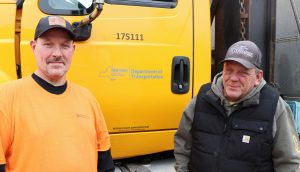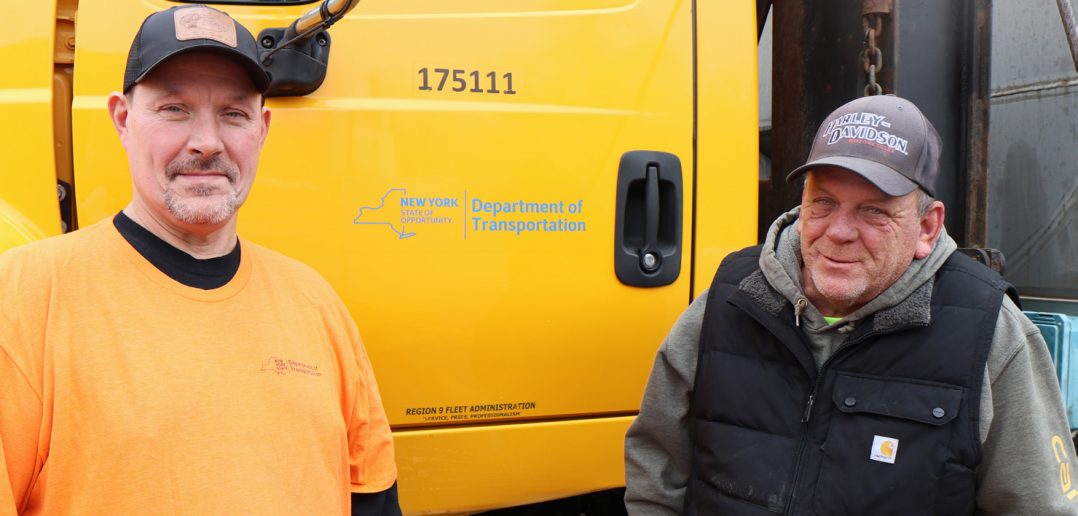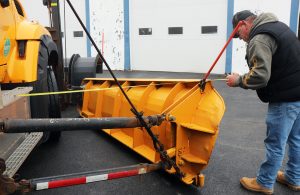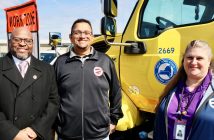
From left, DOT highway maintenance workers Dave Hendrick and Dave
DiMascio pose in front of a plow truck.
SHARON SPRINGS — A loaded state Department of Transportation (DOT) plow truck weighs more than 30 tons or 65,000 pounds.
CSEA members who drive the trucks are often solo, in the dark and navigating bad weather. In addition to clearing the roads, drivers must contend with obstacles like other drivers passing them, vehicles on the side of the road, mailboxes, kids, pets, accidents or in some parts of upstate New York with large Amish populations, horses and buggies.
Schoharie Residency DOT Local President Dave Hendrick, a highway maintenance worker 2, and Schoharie Residency DOT Local Secretary/Treasurer Dave DiMascio, a highway maintenance worker 1, together have clocked more than 40 years on 22 miles of state roads in Schoharie County, which stretch north to Montgomery County, east to Schenectady County and west toward Otsego County.
They’ve seen a lot.
“We’re always out,” said Hendrick. “We have to drive in conditions the public doesn’t want to drive in.”
Both Hendrick and DiMascio run one-person plows with double-wingers. Each wing is 6 feet long, the blades are sharp and the truck is heavy, making it dangerous for people to encounter one with their car.
“If a plow connects with your car, it will open it up like a can opener,” said DiMascio.
But that doesn’t stop people from doing some really stupid things.
“I’ll have someone pass me, speeding, going up a hill,” said DiMascio. “I’ll come down the other side of the hill and see the car parked outside Stewart’s.”
“Everyone is always in such a hurry, and we’re just out there in their way,” said Hendrick. “It’s really tough to explain unless you’re in the truck.”
Hendrick and DiMascio said that distracted driving has gotten worse since when they started working at DOT. Hendrick said that he thinks cell phones are a big part of the problem, combined with people being in a rush.
“I pass people texting all the time,” said Hendrick. “I’ve seen people applying makeup, looking everywhere but the road.”
Plow drivers are de facto first responders in the communities they work in. Often, they will go to accident scenes and make sure conditions near hospitals are safe for emergency staff and ambulances.
“If there is a fire, the roads will be wet and we will make sure to add more material to keep the roads safe,” said Hendrick.
DiMascio has found homes on fire, assisted families in accidents and even was asked to serve as backup to local police at the scene of a drunk driving accident.
Protecting their own safety while trying to make the roads safe for others can be exhausting, noted the workers. They also said that drivers are mindful of the power and weight of the trucks and must remain vigilant and anticipate obstacles.
Hendrick and DiMascio are among the DOT drivers who want to see more front-line employees’ ideas come to fruition to boost safety for employees and the driving public. They noted that engineers and managers who work in offices don’t always have the real-world perspective that workers do.
They also want to see more public education about the meaning of lights and signs that DOT uses to convey traffic patterns on the road. One example of such a pattern using four dots to convey an upcoming lane closure instead of an arrow.
“I ask my girlfriend, my kids and nobody knows what it is,” said DiMascio.
“Arrows are better. People know what an arrow means,” said Hendrick.
Hendrick and DiMascio said they are hoping some new Thruway initiatives will be expanded to DOT.
The first is the addition of green lights so people can see the plows easier, something DOT workers like Hendrick and DiMascio have been suggesting for years.
In November, the New York State Thruway Authority launched a new pilot program that uses digital technology to alert drivers of snowplows in their vicinity. The real-time alerts go directly to drivers using navigation apps like Waze or Google, similar to the way the apps warn of upcoming accidents or objects in the road.
Hendrick and DiMascio say cameras in work zones and the presence of law enforcement has been effective in slowing people down. They would like to see all work zones have a police presence as happens in Massachusetts.
One of our union’s biggest priorities during this year’s legislative session will be pushing for legislation that improves work zone safety.
“Our biggest goal is to get home. I like to go to work, do my job and get home,” said Hendrick.
— Therese Assalian




